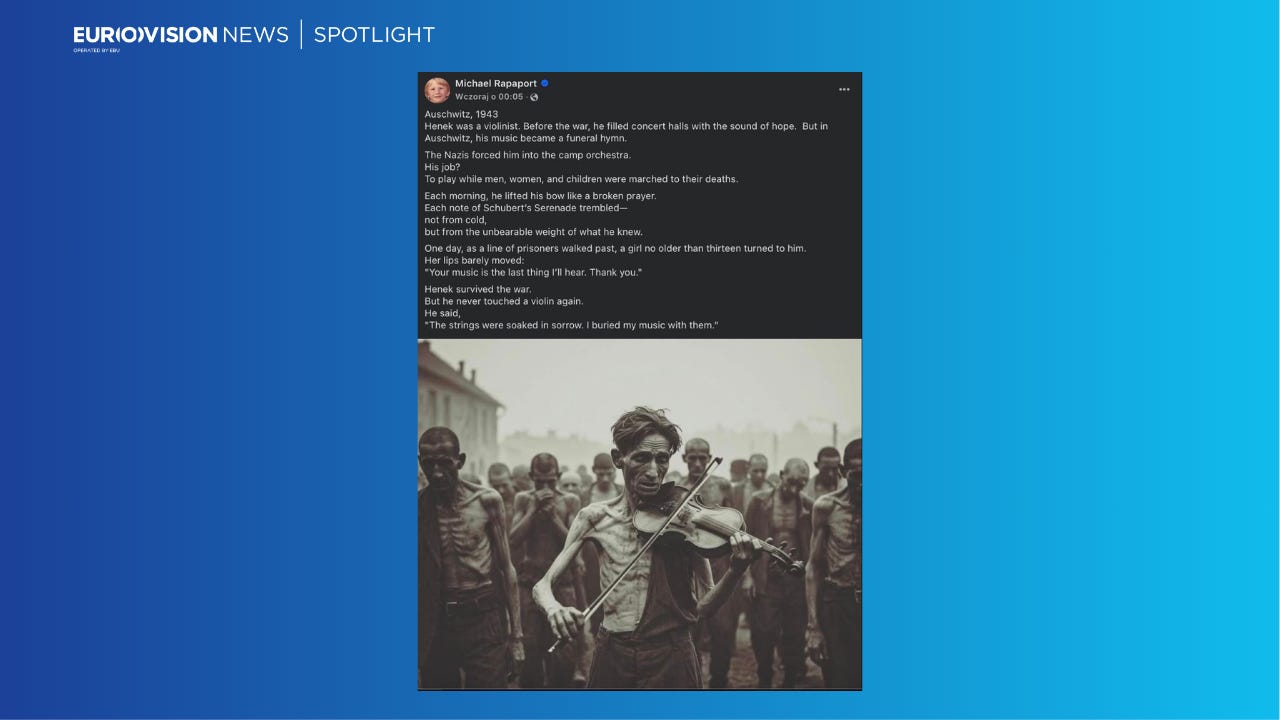Auschwitz Memorial steps in over viral AI photo of violinist
There were inconsistencies in the image, and the Auschwitz Memorial began replying to posts to debunk the story
CLAIM
A photo depicting a prisoner in a concentration camp playing the violin has been widely shared claiming to show a violinist leading other prisoners to the gas chamber in Auschwitz.
BACKGROUND
At the start of July, a black and white photo showing an emaciated man playing the violin began being shared on social media. It was described as taken in 1943, showing a Jewish violinist named “Henek” in the Nazi concentration camp Auschwitz-Birkenau being forced to play as prisoners were led to the gas chamber.
Slightly differing versions of the story in circulation described him playing Schubert’s Serenade and being thanked by a teenage girl telling him that his music is the last thing she will hear. Henek, so the stories continue, survived Auschwitz but never picked up the violin again.
In some versions of the story the girl was 13 and in others 16.
The image began being widely shared at the start of July on several social media platforms but appeared to be most prolific on Facebook where a search for “Henek Auschwitz” and “violinist Auschwitz” returns many of the posts — some now slapped with warnings but many also simply left as they were. Above is a post that was taken from a Facebook page purporting to publish historical photos, where it was shared over 12,000 times. However, several other posts were also shared thousands of times.
It was also shared with the story retold in different languages, proving that the photo was being picked up across countries. The X post below was shared by an Athens-based user.
METHOD
We ran the image through two AI detection tools online — undetectable.ai and wasitai.com — and both returned results indicating a high likelihood the image was AI-generated. On closer inspection, one tell-tale sign that it could not be real included the fact the violin only appeared to have three strings and not four.
As the image stoked considerable interest on social media and spread rapidly, the Auschwitz Memorial intervened, issuing a statement saying: “Publishing fake, AI-generated images of Auschwitz is not only a dangerous distortion. Such fabrication disrespects victims and harasses their memory.”
It added that the story spun around the image was also highly unlikely.
The memorial wrote:
a) “Henek” is a misspelled form of “Heniek” which comes from the Polish name Henryk. No surname is added, which should be the case as the story indicates he was a known musician and a survivor.
b) Orchestras at Auschwitz did not play “while men, women, and children were marched to their deaths”. Their main job was to play when columns of prisoners walked out to work and marched back to the camp
c) Men’s orchestra played in the men’s camp – a story of a girl walking past the men’s orchestra is very much not probable.
American actor and podcast host Michael Rapaport shared the images along with an even more embellished version of the story giving voice to Henek and the young girl with quotes. The outspoken supporter of Israel deleted his post but not before the Auschwitz Memorial got a screenshot. Rapaport, purportedly quoting Henek’s own words, wrote: “The strings were soaked in sorrow. I buried my music with them.”
Rapaport issued what appeared to be a cagey apology on Thursday, saying: “I apologize to any Jewish people that I have offended me by [sic] posting an image that I believed to be real. It could have been real but in this artificial world we live in, it turned out not to be.”
He added: “I’m not going to stop speaking out for the Jewish people and you’re welcome to run any story you want about it. What I did and do is for all the right reasons.”
The Auschwitz Memorial was also active on X trying to debunk some of the most widely shared posts of the image by replying under them.
At the time of writing, X appeared to be cleaning the posts out of its algorithm with the photo first featuring prominently in keyword searches and hours later largely removed from the feed.
Perhaps the most striking aspect of this example of AI-generated material being shared is that while many versions of the image are now showing warnings placed on them by the social media platforms, they are not being removed by many of the larger accounts that are sharing the material. Rapaport wrote in his apology that he acknowledged that the photo was not real but could have been, which, perhaps, was seen as justification enough to publish it.
Many of the accounts we have seen sharing the images have been posting pro-Israel content in relation to Palestine.
Another Facebook user wrote that whether it was “real or not is irrelevant”, claiming the image countered the trivialisation of the Holocaust.
RATING
The image is AI-generated and the story around it is also highly unlikely.
SOURCES
Facebook (2025). Publishing fake, AI-generated images of Auschwitz is not only… [online] [Accessed 11 Jul. 2025].
Facebook (2025). 1943 – Auschwitz, Poland Henek, a violinist, was forced into the camp orchestra… [online] [Accessed 11 Jul. 2025].
Facebook (2025). 1943 – Auschwitz, Poland Henek, a violinist, was forced into the camp orchestra… [online] [Accessed 11 Jul. 2025].
X (2025). Άουσβιτς Μπιργκενάου. Ο Χένεκ συνοδεύει … [online] [Accessed 11 Jul. 2025].
X (2025). The Holocaust is a stain on humanity… [online] [Accessed 11 Jul. 2025].







